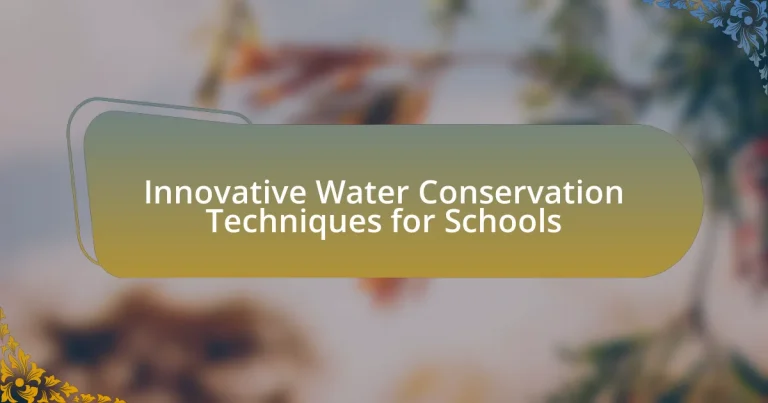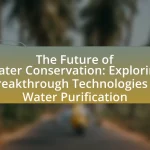Innovative water conservation techniques for schools encompass strategies such as rainwater harvesting, xeriscaping, and the installation of low-flow fixtures. These methods aim to reduce water consumption, alleviate pressure on municipal supplies, and promote sustainability within educational institutions. The article explores the challenges schools face regarding water usage, including aging infrastructure and high consumption rates, and discusses how innovative techniques can mitigate these issues. Additionally, it highlights the importance of water conservation in fostering environmental awareness among students and presents successful case studies that demonstrate effective implementation of these techniques.
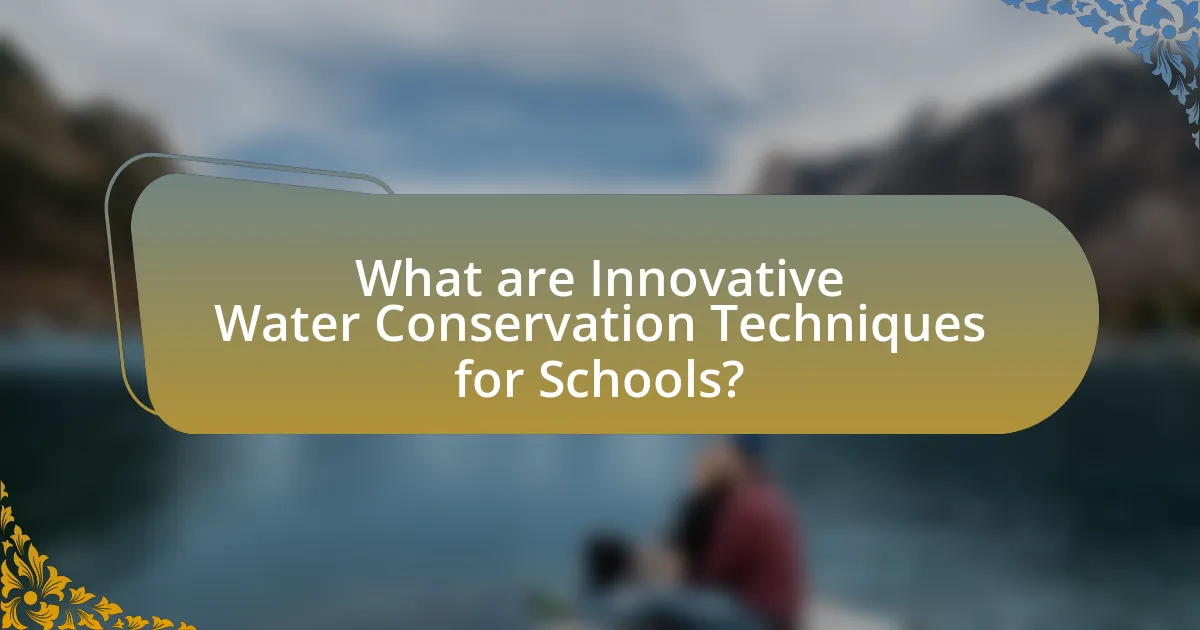
What are Innovative Water Conservation Techniques for Schools?
Innovative water conservation techniques for schools include rainwater harvesting, xeriscaping, and the installation of low-flow fixtures. Rainwater harvesting systems collect and store rainwater for non-potable uses, significantly reducing reliance on municipal water supplies. Xeriscaping involves landscaping with drought-resistant plants, minimizing the need for irrigation. Additionally, low-flow fixtures, such as faucets and toilets, can reduce water consumption by up to 60%, as reported by the U.S. Environmental Protection Agency. Implementing these techniques not only conserves water but also promotes environmental stewardship among students.
How do these techniques address water scarcity issues?
Innovative water conservation techniques for schools address water scarcity issues by implementing strategies that reduce water consumption and enhance water efficiency. Techniques such as rainwater harvesting, which captures and stores rainwater for non-potable uses, can significantly decrease reliance on municipal water supplies. For instance, schools that install rainwater collection systems can reduce their water usage by up to 50%, as reported by the Environmental Protection Agency. Additionally, the use of drought-resistant landscaping minimizes irrigation needs, further conserving water resources. These methods not only alleviate pressure on local water supplies but also promote sustainable practices within the school community.
What specific challenges do schools face regarding water usage?
Schools face specific challenges regarding water usage, including aging infrastructure, high consumption rates, and limited budgets for upgrades. Aging pipes and fixtures often lead to leaks and inefficiencies, resulting in wasted water; for instance, the American Society of Civil Engineers estimates that schools lose millions of gallons annually due to such issues. High consumption rates are driven by the need for water in restrooms, kitchens, and landscaping, which can strain resources, especially in drought-prone areas. Additionally, limited budgets restrict schools’ ability to invest in modern water-saving technologies or infrastructure improvements, making it difficult to implement effective conservation measures.
How can innovative techniques mitigate these challenges?
Innovative techniques can mitigate water conservation challenges in schools by implementing smart irrigation systems, rainwater harvesting, and water-efficient fixtures. Smart irrigation systems utilize sensors and weather data to optimize water usage, reducing waste by up to 50% compared to traditional methods. Rainwater harvesting captures and stores rainwater for non-potable uses, potentially providing up to 30% of a school’s water needs. Additionally, installing water-efficient fixtures, such as low-flow faucets and toilets, can decrease water consumption by 20-60%. These techniques collectively enhance water sustainability in educational institutions, addressing the pressing need for efficient water management.
Why is water conservation important in educational institutions?
Water conservation is important in educational institutions because it promotes sustainability, reduces operational costs, and fosters environmental awareness among students. Educational institutions often consume significant amounts of water for various activities, and implementing water-saving measures can lead to a reduction in water usage by up to 30%, as reported by the U.S. Environmental Protection Agency. This not only lowers utility bills but also serves as a practical example for students, teaching them the value of resource management and encouraging responsible behavior towards the environment.
What impact does water conservation have on school budgets?
Water conservation positively impacts school budgets by reducing utility costs associated with water usage. Schools that implement water-saving measures, such as low-flow fixtures and rainwater harvesting systems, can significantly lower their monthly water bills. For instance, a study by the Environmental Protection Agency found that schools can save up to 30% on water costs through effective conservation strategies. This reduction in expenses allows schools to allocate funds to other essential areas, such as educational resources and facility maintenance, ultimately enhancing the overall financial health of the institution.
How does water conservation contribute to environmental education?
Water conservation significantly enhances environmental education by fostering awareness and understanding of sustainable practices. When students engage in water conservation efforts, they learn about the importance of resource management, ecological balance, and the impact of human activities on the environment. For instance, studies show that schools implementing water-saving initiatives, such as rainwater harvesting and efficient irrigation systems, not only reduce water usage but also serve as practical learning tools. These initiatives provide hands-on experiences that reinforce concepts of sustainability and environmental stewardship, thereby deepening students’ knowledge and commitment to protecting natural resources.
What are the key categories of innovative water conservation techniques?
The key categories of innovative water conservation techniques include rainwater harvesting, greywater recycling, drip irrigation, and smart irrigation systems. Rainwater harvesting captures and stores rainwater for non-potable uses, significantly reducing reliance on municipal water supplies. Greywater recycling involves reusing water from sinks, showers, and washing machines for irrigation or toilet flushing, which can save up to 50% of water usage in schools. Drip irrigation delivers water directly to the roots of plants, minimizing evaporation and runoff, and can reduce water usage by up to 70% compared to traditional irrigation methods. Smart irrigation systems utilize sensors and weather data to optimize watering schedules, ensuring that plants receive the right amount of water while conserving resources. These techniques collectively enhance water efficiency and sustainability in educational institutions.
What role do rainwater harvesting systems play in schools?
Rainwater harvesting systems in schools serve the critical role of providing a sustainable water source for various non-potable uses, such as irrigation, toilet flushing, and cleaning. These systems capture and store rainwater, reducing reliance on municipal water supplies and lowering water bills. According to a study by the Environmental Protection Agency, schools that implement rainwater harvesting can save up to 50% on their water costs, demonstrating the financial and environmental benefits of such systems. Additionally, rainwater harvesting promotes environmental stewardship among students, fostering awareness of water conservation practices.
How can greywater recycling be implemented in educational settings?
Greywater recycling can be implemented in educational settings by installing systems that collect and treat wastewater from sinks, showers, and laundry for reuse in irrigation and toilet flushing. Schools can utilize existing infrastructure by retrofitting plumbing systems to divert greywater into storage tanks equipped with filtration and disinfection processes, ensuring safety and compliance with local regulations. For instance, a study by the University of California found that schools implementing greywater systems reduced water usage by up to 50%, demonstrating both environmental and economic benefits. Additionally, educational programs can be developed to teach students about the importance of water conservation and the science behind greywater recycling, fostering a culture of sustainability within the school community.
How can schools effectively implement these techniques?
Schools can effectively implement innovative water conservation techniques by integrating systems such as rainwater harvesting, drip irrigation, and water-efficient fixtures. For instance, installing rainwater collection systems can reduce dependency on municipal water supplies, as evidenced by a study from the University of California, which found that schools utilizing rainwater harvesting saved up to 50% on water costs. Additionally, adopting drip irrigation for landscaping minimizes water waste by delivering water directly to plant roots, which has been shown to reduce water usage by 30-50% compared to traditional irrigation methods. Furthermore, retrofitting existing plumbing with low-flow faucets and toilets can lead to significant reductions in water consumption, with the U.S. Environmental Protection Agency reporting that low-flow fixtures can save an average of 1.6 gallons per minute. By combining these techniques, schools can create a comprehensive water conservation strategy that not only conserves resources but also educates students about sustainability practices.
What steps should schools take to assess their water usage?
Schools should conduct a comprehensive water audit to assess their water usage. This audit involves measuring water consumption across various facilities, including restrooms, kitchens, and irrigation systems, to identify patterns and areas of excessive use. Schools can utilize water meters to track usage over time, enabling them to establish a baseline for comparison. Additionally, analyzing billing records can provide insights into monthly and seasonal water consumption trends. Implementing these steps allows schools to pinpoint inefficiencies and develop targeted strategies for water conservation, ultimately leading to reduced costs and environmental impact.
How can schools engage students and staff in conservation efforts?
Schools can engage students and staff in conservation efforts by implementing hands-on projects that promote awareness and active participation in sustainability practices. For example, schools can establish a student-led environmental club that organizes activities such as tree planting, recycling drives, and water conservation workshops. Research indicates that experiential learning significantly enhances student engagement; a study by the National Environmental Education Foundation found that students involved in hands-on environmental projects show a 50% increase in their understanding of conservation issues. Additionally, integrating conservation topics into the curriculum can foster a culture of sustainability, encouraging both students and staff to adopt eco-friendly practices in their daily routines.
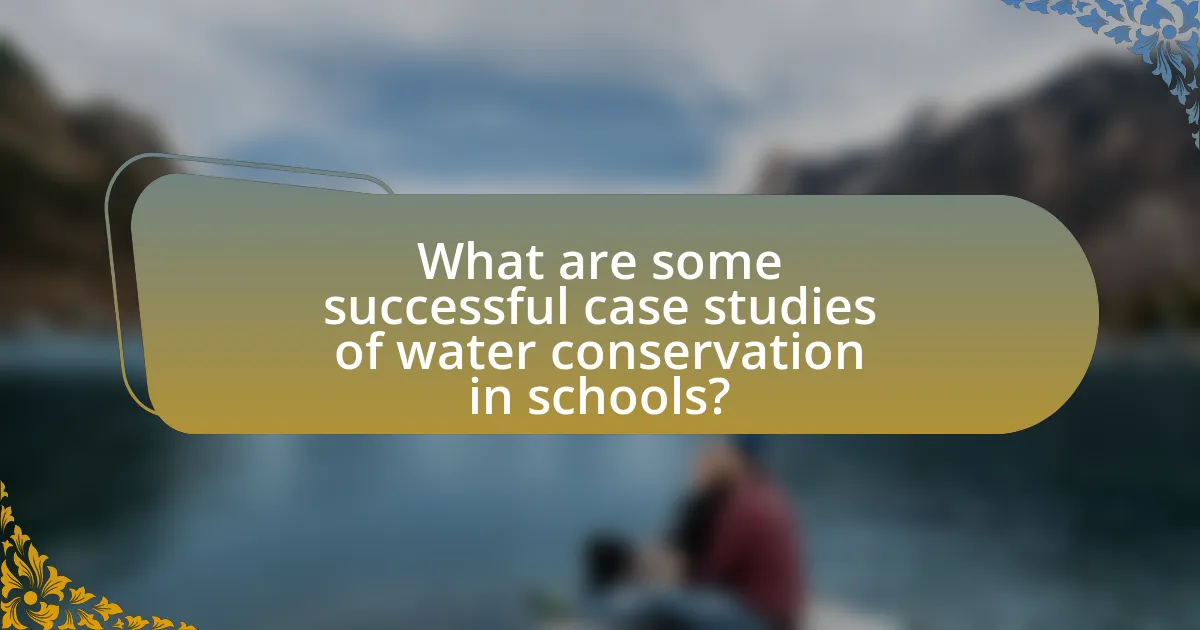
What are some successful case studies of water conservation in schools?
Successful case studies of water conservation in schools include the Green School in Bali, Indonesia, which utilizes rainwater harvesting systems and natural filtration methods, resulting in a 60% reduction in water usage. Another example is the San Diego Unified School District in California, which implemented a district-wide water conservation program that led to a 20% decrease in water consumption over five years through the installation of low-flow fixtures and irrigation systems. Additionally, the EcoSchool program in Canada has demonstrated success by integrating water conservation education into the curriculum, leading to a 30% reduction in water use across participating schools. These case studies illustrate effective strategies and measurable outcomes in water conservation efforts within educational institutions.
What techniques were used in these successful case studies?
Successful case studies in innovative water conservation techniques for schools utilized methods such as rainwater harvesting, xeriscaping, and the installation of low-flow fixtures. Rainwater harvesting systems effectively collect and store rainwater for irrigation and non-potable uses, significantly reducing reliance on municipal water supplies. Xeriscaping, which involves landscaping with drought-resistant plants, minimizes water usage while maintaining aesthetic appeal. Additionally, low-flow fixtures, including faucets and toilets, decrease water consumption without compromising functionality. These techniques have been proven to lower water bills and promote sustainable practices within educational institutions.
How did these techniques lead to measurable water savings?
Innovative water conservation techniques for schools led to measurable water savings by implementing efficient irrigation systems, rainwater harvesting, and water-efficient fixtures. These methods reduced overall water consumption significantly; for instance, schools that adopted smart irrigation systems reported up to 30% less water usage compared to traditional methods. Additionally, rainwater harvesting systems can capture thousands of gallons annually, providing a sustainable water source for landscaping and non-potable uses. The installation of low-flow toilets and faucets further contributed to water savings, with some schools achieving reductions of 20-50% in restroom water use. These quantifiable reductions demonstrate the effectiveness of these techniques in conserving water resources in educational institutions.
What lessons can other schools learn from these examples?
Other schools can learn the importance of implementing innovative water conservation techniques to reduce water usage and promote sustainability. For instance, schools that have adopted rainwater harvesting systems have reported significant reductions in their water bills and increased awareness among students about environmental stewardship. Additionally, integrating smart irrigation systems has allowed schools to optimize water usage for landscaping, leading to healthier plants and lower maintenance costs. These examples demonstrate that proactive measures in water conservation not only benefit the environment but also enhance educational opportunities by engaging students in real-world sustainability practices.
How do community partnerships enhance water conservation efforts?
Community partnerships enhance water conservation efforts by fostering collaboration between schools, local governments, and organizations, which leads to more effective resource management and educational outreach. These partnerships enable schools to implement innovative conservation techniques, such as rainwater harvesting and xeriscaping, while also providing access to funding and expertise. For instance, a study by the American Water Works Association found that community engagement in water conservation initiatives can increase participation rates by up to 50%, demonstrating the significant impact of collaborative efforts on promoting sustainable practices.
What types of organizations can schools partner with for water conservation?
Schools can partner with environmental organizations, government agencies, non-profits focused on sustainability, local water utilities, and educational institutions for water conservation. These partnerships can facilitate access to resources, expertise, and funding opportunities. For instance, organizations like the Environmental Protection Agency (EPA) provide educational materials and grants for water-saving initiatives, while local water utilities often offer programs that support schools in implementing water-efficient practices.
How can these partnerships provide resources and expertise?
Partnerships can provide resources and expertise by leveraging the strengths of various stakeholders, such as local governments, non-profits, and educational institutions. These collaborations often result in access to funding, technical knowledge, and best practices in water conservation. For instance, partnerships with environmental organizations can offer schools specialized training on innovative techniques like rainwater harvesting or xeriscaping, which are proven methods for reducing water usage. Additionally, data from the U.S. Environmental Protection Agency indicates that schools implementing such partnerships can achieve up to a 30% reduction in water consumption, demonstrating the effectiveness of collaborative efforts in resource management.
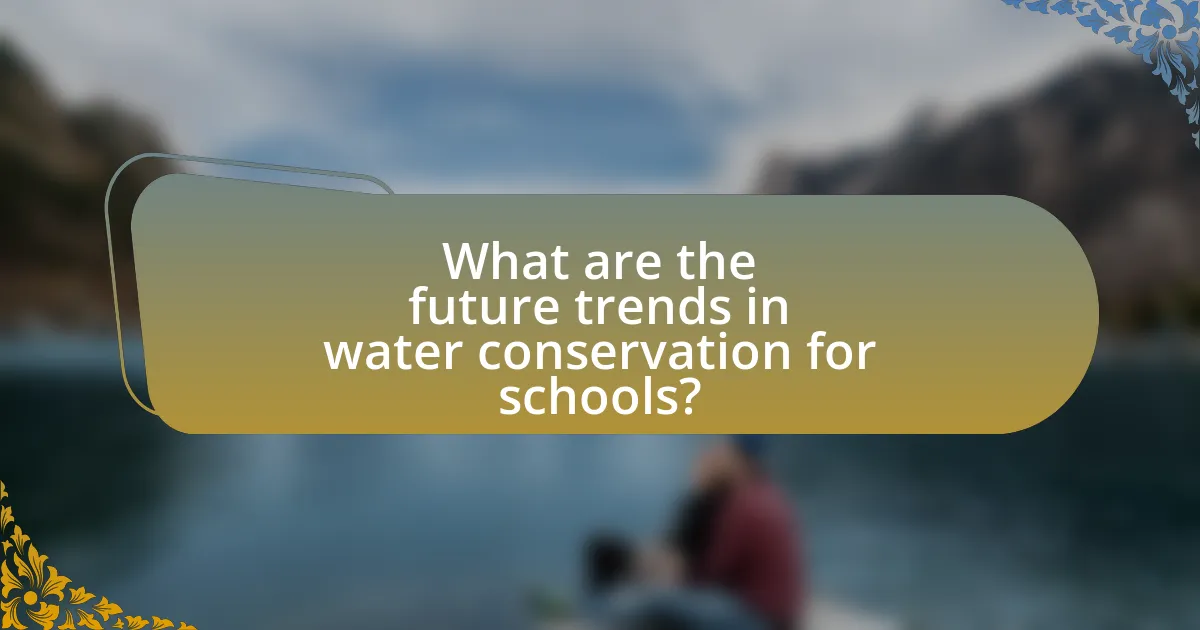
What are the future trends in water conservation for schools?
Future trends in water conservation for schools include the implementation of smart irrigation systems, rainwater harvesting, and the use of water-efficient fixtures. Smart irrigation systems utilize sensors and weather data to optimize water usage, significantly reducing waste. Rainwater harvesting allows schools to collect and store rainwater for non-potable uses, which can decrease reliance on municipal water supplies. Additionally, the installation of water-efficient fixtures, such as low-flow toilets and faucets, can lead to substantial reductions in water consumption. According to the U.S. Environmental Protection Agency, schools can save up to 30% of their water usage by adopting these technologies, demonstrating their effectiveness in promoting sustainable water management practices.
How is technology shaping the future of water conservation in education?
Technology is shaping the future of water conservation in education by enabling real-time monitoring and data analysis of water usage in schools. Smart sensors and IoT devices allow educational institutions to track water consumption patterns, identify leaks, and optimize irrigation systems, leading to significant reductions in water waste. For instance, a study by the Water Research Foundation found that schools implementing smart water management systems reduced their water usage by up to 30%. Additionally, educational software and mobile applications are being developed to teach students about water conservation practices, fostering a culture of sustainability among future generations.
What innovative technologies are emerging in water conservation?
Innovative technologies emerging in water conservation include smart irrigation systems, rainwater harvesting systems, and water-efficient fixtures. Smart irrigation systems utilize sensors and weather data to optimize water usage, reducing waste by up to 50% compared to traditional methods. Rainwater harvesting systems capture and store rainwater for non-potable uses, significantly decreasing reliance on municipal water supplies. Water-efficient fixtures, such as low-flow faucets and toilets, can reduce water consumption by 30% or more. These technologies collectively contribute to sustainable water management practices in educational institutions.
How can schools leverage data analytics for better water management?
Schools can leverage data analytics for better water management by utilizing real-time monitoring systems to track water usage patterns and identify inefficiencies. By analyzing data from water meters and sensors, schools can pinpoint areas of excessive consumption, such as leaks or high-use facilities, allowing for targeted interventions. For instance, a study by the American Water Works Association found that implementing data-driven strategies can reduce water usage by up to 30%. This approach not only promotes conservation but also leads to significant cost savings on water bills, reinforcing the effectiveness of data analytics in optimizing water management in educational institutions.
What best practices should schools follow for ongoing water conservation?
Schools should implement regular water audits to identify areas of excessive use and potential leaks. Conducting these audits allows schools to monitor water consumption patterns and address inefficiencies, leading to significant reductions in water waste. For instance, a study by the U.S. Environmental Protection Agency found that schools can save up to 30% on water bills by fixing leaks and optimizing usage. Additionally, schools should install low-flow fixtures and irrigation systems that use smart technology to minimize water usage while maintaining landscaping. These practices not only conserve water but also promote environmental stewardship among students and staff.
How can schools create a culture of sustainability among students?
Schools can create a culture of sustainability among students by integrating environmental education into the curriculum and promoting hands-on activities related to sustainability. This approach encourages students to understand the importance of conserving resources, such as water, and empowers them to take action. For instance, implementing projects like school gardens or water conservation initiatives can provide practical experience. Research shows that experiential learning significantly enhances students’ environmental awareness and behavior, as evidenced by a study published in the Journal of Environmental Education, which found that students involved in hands-on sustainability projects demonstrated a 30% increase in environmentally responsible behaviors.
What resources are available for schools to stay updated on water conservation techniques?
Schools can access various resources to stay updated on water conservation techniques, including online platforms, educational organizations, and government initiatives. Websites such as the U.S. Environmental Protection Agency (EPA) provide comprehensive guides and toolkits specifically designed for educators, detailing best practices in water conservation. Additionally, organizations like the Alliance for Water Efficiency offer webinars and workshops that focus on innovative water-saving strategies. State and local water agencies often publish newsletters and host community events that inform schools about the latest technologies and methods in water conservation. These resources ensure that schools remain informed and can implement effective water-saving measures.
